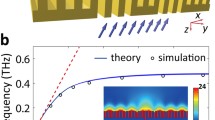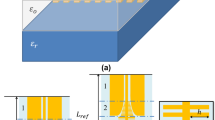Abstract
Since surface plasmons (SPs) are not constrained by the diffraction limit, they have important potential applications in the optical, terahertz (THz), and microwave components. In this paper, we firstly present a review of three-dimensional (3D) bidirectional and multi-directional THz SP splitters based on the rectangular metallic groove gratings with finite thickness, in which a metallic wire was used to excite the THz SPs. The experimental verifications of such splitters have been implemented in the microwave frequencies, and the measurement results have excellent agreements to the full-wave simulations. To improve the performance, a 3D bidirectional THz SP splitter with the transverse confinement and a 3D bidirectional bending THz SP splitter are then proposed, which have shown very good splitting performance, compact sizes, and better transverse confinement of EM fields. Finally, a broadband slow-wave system of subwavelength thickness is reviewed and a new bending slow-wave system utilizing THz SPs is proposed. Experiments and simulations in microwave frequencies have good agreements, showing the validity of these components.
Similar content being viewed by others
References
Ozbay E. Plasmonics: merging photonics and electronics at nanoscale dimensions. Science, 2006, 311: 189
Barnes W L. Dereux A, Ebbesen T W. Surface plasmon sub-wavelength optics. Nature, 2003, 424: 824
Gan Q, Fu Z, Ding Y J, et al. Bidirectional subwavelength slit splitter for THz surface plasmons. Opt Expr, 2007, 15:18050
Caglayan H, Ozbay E. Surface wave splitter based on metallic gratings with sub-wavelength aperture. Opt Expr, 2008, 16: 19091
Gan Q, Bartoli F J. Bidirectional surface wave splitter at visible frequencies. Opt Lett, 2010, 35: 4181–4183
Gramotnev D K, Pile D F P. Single-mode subwavelength waveguide with channel plasmon-polaritons in triangular grooves on a metal surface. Appl Phys Lett, 2004, 85: 6323
Pile D F P, Gramotnev D K. Channel plasmon-polariton in a triangular groove on a metal surface. Opt Lett, 2004, 29:1069
Bozhevolnyi S I, Volkov V S, Devaux E, et al. Channel plasmon-polariton guiding by subwavelength metal grooves. Phys Rev Lett, 2005, 95: 046802
Bozhevolnyil S I, Volkov V S, Devaux E, et al. Channel plasmon subwavelength waveguide components including interferometers and ring resonators. Nature, 2006, 440: 508–511
Volkov V S, Bozhevolnyi S I, Devaux E, et al. Wavelength selective nanophotonic components utilizing channel plasmon polaritons. Nano Lett, 2007, 7: 880
Volkov V S, Bozhevolnyi S I, Devaux E, et al. Bend loss for channel plasmon polaritons. Appl Phys Lett, 2006, 89: 143108
Pile D F P, Gramotnev D K. Plasmonic subwavelength waveguides: next to zero losses at sharp bends. Opt Lett, 2005, 30: 1186
Gan Q, Fu Z, Ding Y J, et al. Ultrawide-bandwidth slow-light system based on THz plasmonic graded metallic grating structures. Phys Rev Lett, 2008, 100: 256803
Gan Q, Ding Y J, Bartoli F J. “Rainbow” trapping and releasing at telecommunication wavelengths. Phys Rev Lett, 2009, 102: 056801
Chen L, Wang G P, Gan Q, et al. Trapping of surface-plasmon polaritons in a graded Bragg structure: Frequency-dependent spatially separated localization of the visible spectrum modes. Phys Rev B, 2009, 80: 161106
Chen L, Wang G P, Gan Q, et al. Rainbow trapping and releasing by chirped plasmonic waveguides at visible frequencies. Appl Phys Lett, 2010, 97: 153115
Gan Q, Gao Y, Wagner K, et al. Experimental verification of the “rainbow” trapping effect in adiabatic plasmonic gratings. In: Quantum Electronics and Laser Science Conference. OSA Technical Digest, 2011
Zhou Y J, Jiang Q, Cui T J. Bidirectional surface wave splitters excited by a cylindrical wire. Opt Expr, 2011, 19: 5260–5267
Zhou Y J, Cui T J. Multi-directional surface wave splitters. Appl Phys Lett, 2011, 98: 221901
Zhou Y J, Cui T J. Broadband slow-wave systems of subwavelength thickness excited by a metal wire. Appl Phys Lett, 2011, 99: 101906
Wang K, Mittleman D M. Metal wires for terahertz wave guiding. Nature, 2004, 432: 376
Deibel J A, Wang K, Escarra M D, et al. Enhanced coupling of terahertz radiation to cylindrical wire waveguides. Opt Expr, 2006, 14: 279
Zhou Y J, Jiang Q, Cui T J. Bidirectional bending splitter of designer surface plasmons. Appl Phys Lett, 2011, 99: 111904
Author information
Authors and Affiliations
Corresponding author
Additional information
ZHOU YongJin was born in 1982, received the B.S. degree in communication engineering from Shandong University, Ji’nan, in 2006, and received the Ph.D. degree in electromagnetic field and microwave technology from Southeast University, Nanjing, in 2011. His research interests include computational electromagnetics, metamaterials, and their applications. He is working in Marvell Technology (Shanghai) Ltd.
CUI TieJun received the B.S., M.Sc., and Ph.D. degrees in electrical engineering from Xidian University, Xi’an, China, in 1987, 1990, and 1993, respectively. In 1993, he joined the Department of Electromagnetic Engineering, Xidian University. From 1995 to 1997 he was a Research Fellow with the Institut fur Hochstfrequenztechnik und Elektronik (IHE) at the University of Karlsruhe, Germany. In 1997, he joined the Center for Computational Electromagnetics, Department of Electrical and Computer Engineering, University of Illinois at Urbana-Champaign. In 2001, he became a Cheung-Kong Professor with the Department of Radio Engineering, Southeast University, Nanjing. Currently, he is the Associate Dean with the School of Information Science and Engineering, and the Associate Director of the State Key Laboratory of Millimeter Waves. His research interests include computational electromagnetics, metamaterials, and their applications.
JIANG Quan was born in 1985, received the B.S. degree in information engineering from Southeast University, Nanjing, in 2009, and is studying for the M.Sc. degree in electromagnetic field and microwave technology from Southeast University.
Rights and permissions
About this article
Cite this article
Zhou, Y., Jiang, Q. & Cui, T. Three-dimensional subwavelength components utilizing THz surface plasmons. Sci. China Inf. Sci. 55, 79–89 (2012). https://doi.org/10.1007/s11432-011-4509-z
Received:
Accepted:
Published:
Issue Date:
DOI: https://doi.org/10.1007/s11432-011-4509-z




